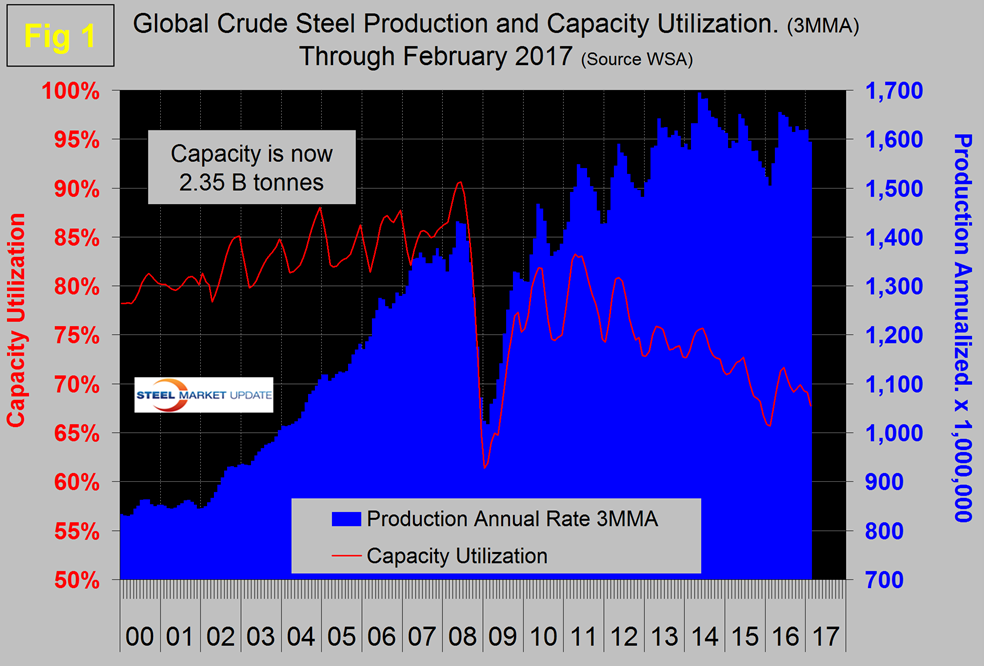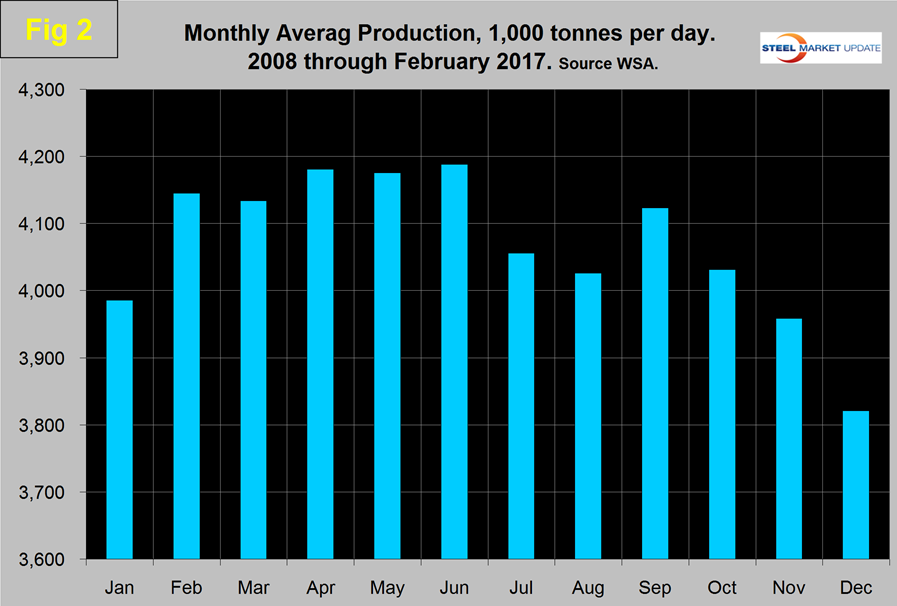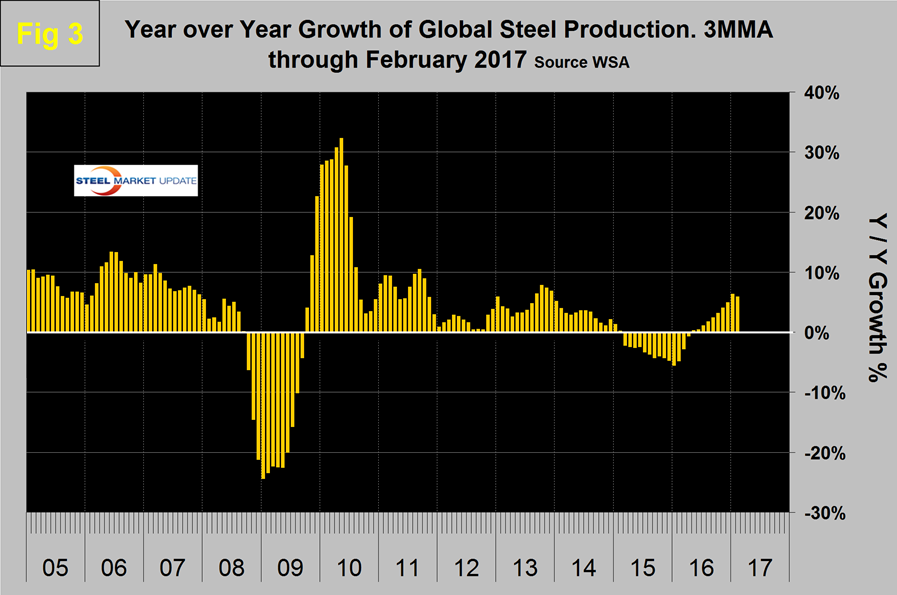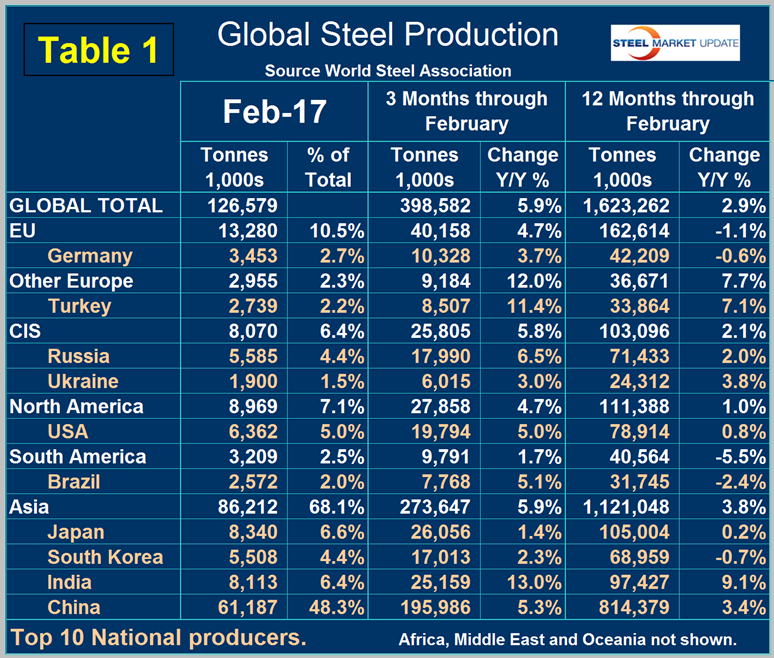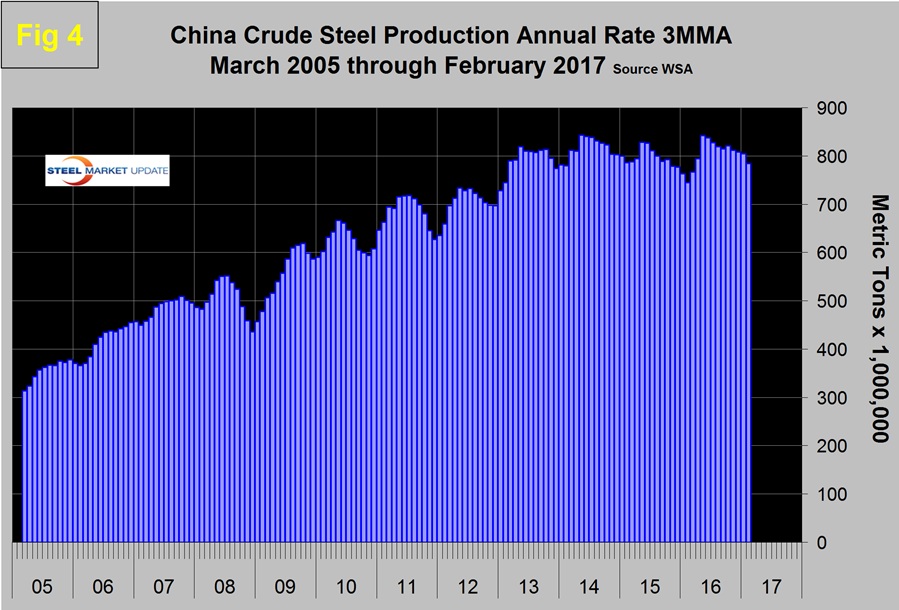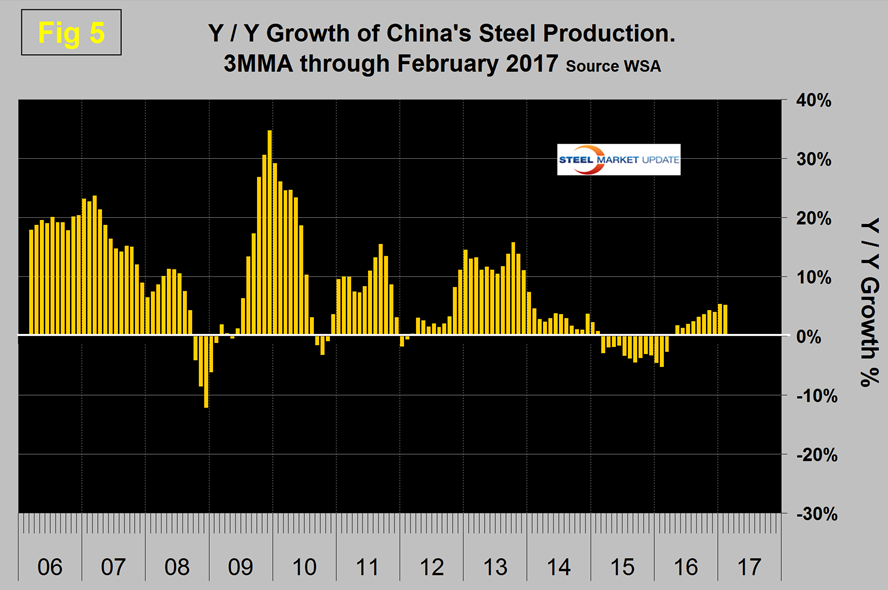Steel Products Prices North America

Global Steel Production in February and Forecast through 2017
Written by Peter Wright
March 22, 2017
Production in the month of February was 126,579,000 metric tons, down from 137,837,000 tons in January. Capacity utilization fell from 69.2 to 65.5 The three month moving averages (3MMA) that we prefer to use were 132,861,000 and 67.8 percent respectively. This capacity utilization number is misleading because in February it was severely influenced by the short month. Capacity is 2.35 billion tonnes per year. Figure 1 shows monthly production and capacity utilization since February 2000.
On a tons per day basis (t/d) production in February was 4.521 million tonnes with a 3MMA of 4.432 which was the highest t/d result since June 2014. The growth of daily production month on month on a 3MMA basis was 0.7 percent which was up from 0.1 percent in January. Since 2011, capacity utilization has been on an erratically downward trajectory. On October 9th the OECD’s steel committee reported that global capacity is expected to increase by almost 58 million tonnes/year between 2016 and 2018 bringing the total to 2.43 billion tonnes.
As we dig deeper into what is going on we start with seasonality. Global production has peaked in the summer for the last seven years. Figure 2 shows the average tons/day production for each month since 2008.
In those ten years on average, February has increased by 4.0 percent, this year February increased by 1.95 percent. Figure 3 shows the monthly year over year growth rate on a 3MMA basis since February 2005.
Production began to contract in March 2015 and the contraction accelerated through February 2016 when it reached 5.5 percent. In the next four months contraction slowed and in May growth became positive. Since then growth accelerated every month to reach 6.3 percent in January before declining to 5.9 percent in February. For the last three months China’s growth rate has been lower than the rest of the world. This will take a little bit of pressure off the global market.
Table 1 shows global production broken down into regions and also the production of the top ten nations in the single month of February and their share of the global total. It also shows the latest three months and twelve months production through February with year over year growth rates for each period. Regions are shown in white font and individual nations in beige.
The world as a whole had positive growth of 5.9 percent in 3 months and 2.9 percent in 12 months through February. If the three month growth rate exceeds the twelve month we interpret this to be a sign of positive momentum which has been the case for the last thirteen months. In February China’s share of global production was 48.3 percent, which followed 49.2 percent in January. These were the first months below 50 percent since July last year.
Figure 4 shows China’s production since 2005 and Figure 5 shows the y/y growth.
China’s production after slowing for 13 straight months year over year returned to positive growth each month in May through February on a 3MMA basis. It may look from Figure 4 as though China’s production is falling but on a y/y basis this is not the case. Therefore the slowdown in Chinese steel production that they have been promising is not happening.
In 3 months through February y/y every region and all of the top 10 producing nations had positive growth. Asia as a whole was up by 5.9 percent with India up by 13.0 percent. Other Europe (mainly Turkey), was up by 12.0 percent and North America was up by 4.7 percent. Within North America the US was up by 5.0 percent, Canada was down by 3.1 percent and Mexico up by 12.8 percent.
The October 2016 version of the World Steel Association Short Range Outlook (SRO) for apparent steel consumption in 2016 and 2017 forecast a global growth of 0.2 percent in 2016 and 0.5 percent in 2017. Note this forecast is steel consumption, not crude steel production which is the main thrust of what you are reading now. As it turned out global production in 2016 beat this forecast which suggests that the surge in the 4th quarter was unexpected. Based on this forecast, NAFTA was supposed to contract by 0.1 percent in 2016 and it actually broke even. China’s demand was expected to decline by 1.0 percent in 2016 when in fact it grew by 1.5 percent and is forecast to grow by 2.0 percent in 2017. The WSA forecast for the top 10 steel producing nations has the US up 3.0 percent this year. The next short range outlook will be published next month.
SMU Comment: There is a difference between capacity and production and China’s efforts to reduce both capacity and pollution are not translating into lower production. It looks as though global demand is expanding, however China is still exporting more than the total US steel output. An acceleration of plant closures will be necessary to make a real dent. At the same time new plants are coming on stream world wide, the net result of closures and startups according to the OECD will be an additional 58 million tons of capacity by the end of 2018. To make matters worse the IMF in its October update was not optimistic about a pick up in global economic growth and the Chinese currency is weakening. The next forecast of global economic growth by the IMF will be released in April.
Source: World Steel Association with analysis by SMU.

Peter Wright
Read more from Peter WrightLatest in Steel Products Prices North America

Nucor slows HRC price climb with $5/ton increase
After eight weeks of double-digit price increases on hot-rolled (HR) coil, Nucor slowed the price rise this week with an increase of $5 per short ton.

Domestic CRC prices surge ahead of imports
The price spread between stateside-produced CR and imports reached its widest margin in over a year.

Evraz raises plate prices $160/ton
Evraz North America (NA) has followed Nucor and SSAB with a plate price increase of its own: up $160 per short ton (st). The increase was effective immediately for all new orders of carbon, high-strength low-alloy, and normalized and quenched-and-tempered plate products, as well as for hot-rolled coil, the steelmaker said in a letter to […]

Nucor lifts HR coil to $820/ton
Nucor has increased its consumer spot price (CSP) for hot-rolled (HR) coil for a fourth consecutive week.

Nucor pushes HR spot price to $790/ton
Nucor increased its consumer spot price (CSP) for hot-rolled (HR) coil to $790 per short ton (st) on Monday, Feb. 10 – a $15/st bump vs. last week. The Charlotte, N.C.-based company has raised its weekly CSP by $40/st over the past three weeks after maintaining tags at $750/st since Nov. 12, according to SMU’s […]

